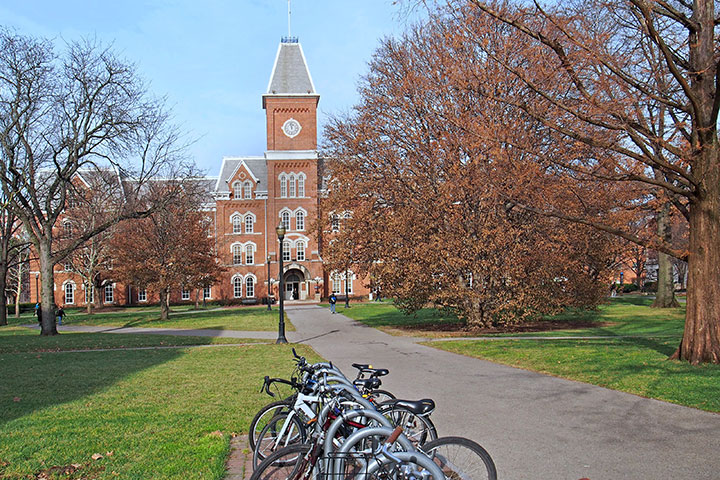College campuses are hubs for innovation, arts, culture and athletics. And when looking back, alumni regularly refer to their university years as some of their best — partly due to their access to a community of higher learning and culture. So, could college campuses also be the ideal place to spend your golden years? Increasingly, communities, universities, and students are considering the idea.
Universities Ideal for Young and Old
Universities provide the community, culture, and infrastructure that seniors not only desire, but need. Think top-tier hospital facilities and fully-equipped gyms for their bodies, as well as access to recreation like sporting events and shows at the playhouse for their minds. Not to mention, campuses provide seemingly endless opportunities to volunteer and learn something new.
The fact is that by 2040, more than 20{d0e74b8a3596e4326b45924d39792f257a1f9983beed4201831d386befd3d18e} of the United States’ population will be over the age of 65. As Andrew Carle, a George Mason professor of health administration and policy, put it,
In the next two decades individuals aged 65 and older will come to represent one of every five U.S. citizens and, more importantly, control more than half of all discretionary income. Their demographic and economic influence will extend to the farthest reaches of American society — from entertainment, to travel, food, retail, technology, and housing.
Intergenerational Housing Has Benefits
And as seniors increasingly move away from the idea of institutionalization and facilities to communities, society is faced with the question of how to help the aging population as their housing needs and desires change.
“We’re going to need to begin thinking outside the box much more regularly to deal with the needs of our aging population,” said Renae Smith-Ray, a research scientist at the Center for Research on Health and Aging at the University of Illinois at Chicago. In speaking to the Chicago Tribune, Smith-Ray explained intergenerational housing opportunities are a great next step.
The Housing Opportunities & Maintenance for the Elderly in Chicago, otherwise known as H.O.M.E, is one of those programs. Under one roof they house the elderly, college students and even a middle-aged couple. The Chicago Tribune explains that the 14 roommates each have their own bedroom but share the bathroom, kitchen and living areas. In these open spaces, the community, and a bond are formed.
“You do become a family,” Caren Arden-Tabani, a housing coordinator who raised her two children in the Pat Crowley House and still lives there with her husband, told the Tribune. “It happens in sort of an organic way.”
The non-profit costs seniors 80{d0e74b8a3596e4326b45924d39792f257a1f9983beed4201831d386befd3d18e} of their income, but they get housing, food, and toiletries covered in those expenses. They also get resident assistance to cook their food on weeknights, and on weekends the youngsters chip in to help – part of their chores for free room and board.
“I’m learning a lot,” 24-year-old Tracy Montes, a student in Chicago and intergenerational roommate, explained to the Tribune. “It keeps me young and it keeps me hopeful. I’m like, ‘What more can I do for them?’”
The H.O.M.E model for intergenerational housing sheds light on the positive effects it has on the elderly residents. As explained in a case study by Karyn Speidel at the University of San Diego, “older adults have shown increased brain function, physical activity, improved health, as well as reduced disability, isolation, and depression.”
University-Based Retirement Communities
But, there’s also something to be said about the idea of housing the elderly on, or adjacent to, universities. Michael Blake, a principal architect at Marks Thomas, recently expanded on some of the greater ideas coming out of this concept.
Blake explained that University-Based Retirement Communities, as they’re coined, not only provide seniors access to educational and social opportunities but give the university students and faculty “teaching, education, employment, volunteering and other opportunities” at a UBRC.
For example, at Lasell Village, a continuing care retirement community on the campus of Lasell College in Newton, MA, the residents are required to develop and satisfy a specified learning plan as a condition of residency in a unique living and learning program. At Kendal at Hanover, at Dartmouth College in Hanover, NH, shares staff with the Dartmouth-Hitchcock Medical Center and provides residents with access to its state-of-the-art health facilities.
It becomes a symbiotic relationship — the elderly relying on the university and built-in community for support, and ultimately their residence helps bolster the local economy, and enrich young minds — as Speidel further explains in her USD case study:
In these settings, all generations share ideas and lives, as well as learn empathy, care, and compassion. Moreover, older generations are offered an opportunity to use their wisdom and experience to guide and empower youth and youth have an opportunity to expose older adults to scientific advances and novel life experiences.
While there are by no means widespread implementations of the college campus intergenerational living models, the programs at hand and ongoing discussion can be seen as promising. What do you think about the idea of intergenerational housing and University-Based Retirement Communities? Let us know in the comments below, and be sure to share this article with your friends on Facebook and Twitter.

Great to read!